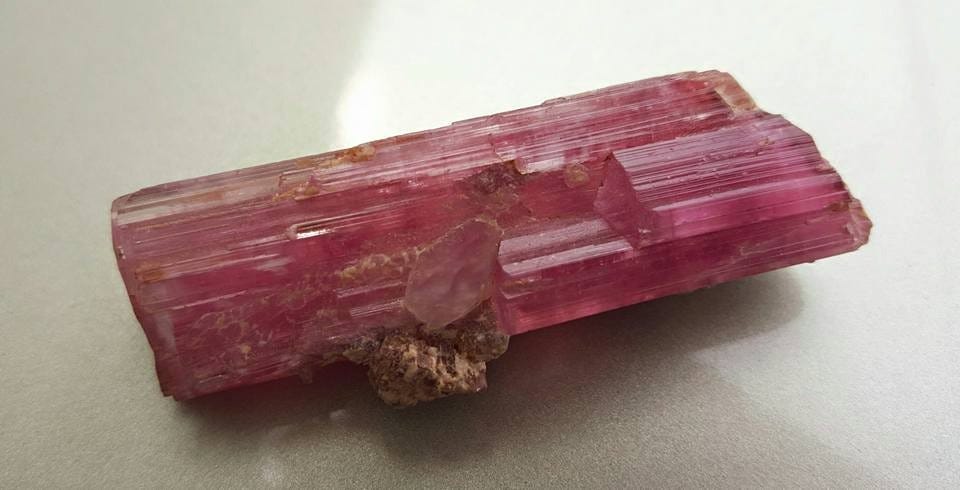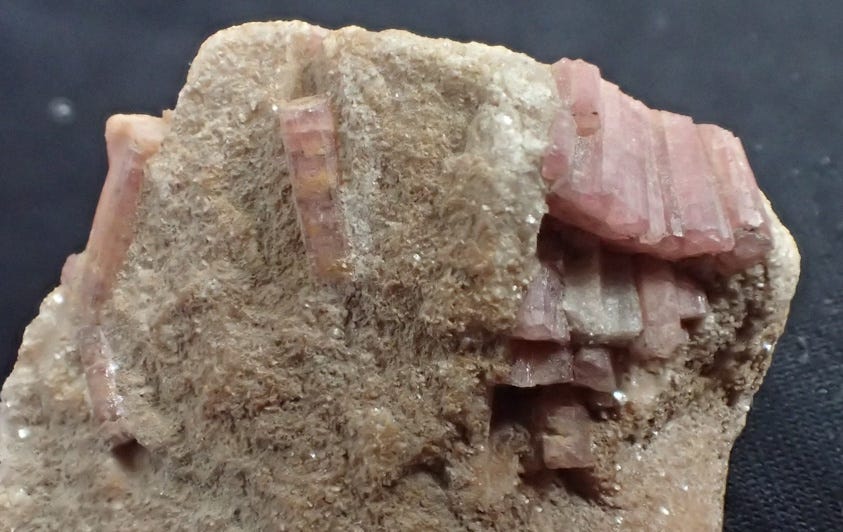Life in the USA is not normal. It feels pointless and trivial to be talking about small looks at the fascinating natural world when the country is being dismantled. But these posts will continue, as a statement of resistance. I hope you continue to enjoy and learn from them. Stand Up For Science!
Tourmaline is a complex calcium/sodium-aluminum-iron boron silicate, but the sizes of the molecular groups in the crystal structure mean that it’s almost a garbage can of elements that can substitute into the crystals. Potassium, sodium, lithium, magnesium, manganese, chromium, titanium, copper, and vanadium are some of the relatively common substituting elements. The varying proportions of everything give tourmaline one of the widest color ranges of any mineral.
High lithium, low iron, and traces of manganese make for a beautiful red-pink variety called rubellite, from the Latin word rubellus meaning reddish. The 5.3-cm specimen in the top photo is from the Pala Chief Mine, Pala, California, one of the classic world localities for rubellite. It’s doubly terminated, although the terminations are complex and add up to almost flat ends.
Most rubellite is probably a variety of the tourmaline-group species elbaite, whose general formula is Na(Al1.5Li1.5)Al6(Si6O18)(BO3)3(OH)3(OH). Elbaite has little or no iron, and the variety rubellite is probably a little more lithium-rich and is often more gemmy than some common tourmalines.
Gemstones have been mined at Pala, north of San Diego, since the 1870s. The minerals occur in pegmatite dikes, late-stage, very coarse-grained bodies that crystallized from magmas of the Peninsular Ranges Batholith complex. Perhaps unexpectedly, the gem-bearing pegmatites often cut gabbroic intrusives rather than granitic bodies; I think pegmatites are more commonly found associated with granites, but certainly not exclusively.
The second photo, above, is probably from Pala (maybe the Stewart Mine) but I can’t be absolutely certain. I found it in the dirt along the road in front of an abandoned rock shop in the Ozarks in 1969.
The Peninsular Ranges Batholith gets its name from the Baja California Peninsula in Mexico, but the intrusive bodies are also found well north into coastal California. They are tectonically similar to and more or less time equivalents of the Sierra Nevada Batholith, subduction-generated magmas emplaced over a long period of time, from about 126 to 80 million years ago (Middle Cretaceous time). The Peninsular Ranges rocks have since been separated from the Sierra Nevada by faulting on the San Andreas zone.
The name tourmaline derives from toramalli, a Sinhalese (the Indo-Aryan language spoken in Sri Lanka) word that referred to many kinds of colored stones. Rinmann used it in 1766 (as tourmalin) as a name for the group we call tourmaline today, with the final name tourmaline from Irish geologist and chemist Richard Kirwan (1733-1812) in 1794. Kirwan lived 78 years despite his eccentricities, which included paying his servants to kill flies, which he had an aversion to, and a diet exclusively of ham (always and only cooked on Sunday, then reheated through the week) and milk. He also had a pet eagle.
The tourmaline group includes at least 44 named species, ranging from well-known minerals such as uvite, elbaite, schorl, and dravite, to more obscure examples like chromo-alumino-povondraite.
Cat. No. 118 and 475.







Do you read steve sorrells thread? On tourmaline, the other day, I mentioned the curator at Seaman's institute. I met him there, he said " elbaite can be black." I had read somewhere of that sentiment. Forget color except as a trade name.
But coolio, I never knew where the word "tourmaline " came from. Thx.
Man, you hang out with wierd ppl...ugh, ham....
Maybe Richard Kirwan was onto something with his carnivore diet and killing flies!